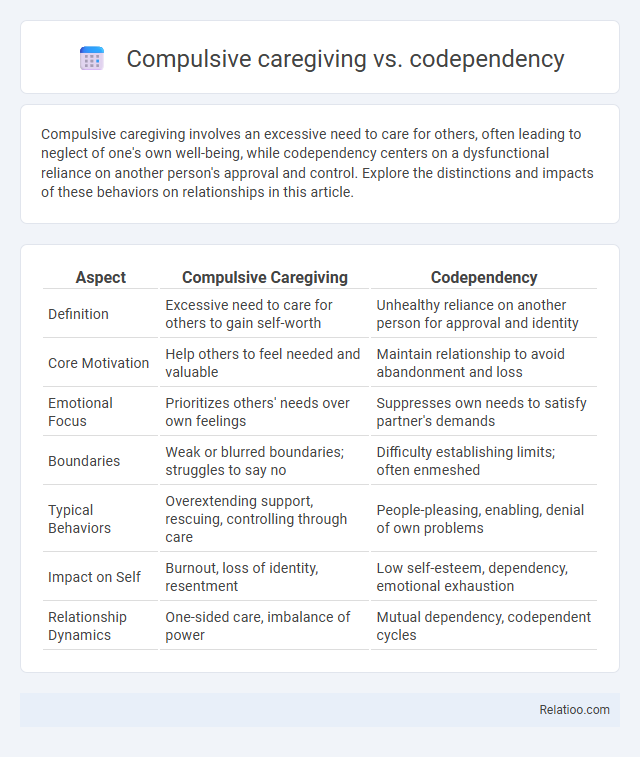Compulsive caregiving involves an excessive need to care for others, often leading to neglect of one's own well-being, while codependency centers on a dysfunctional reliance on another person's approval and control. Explore the distinctions and impacts of these behaviors on relationships in this article.
Table of Comparison
| Aspect | Compulsive Caregiving | Codependency |
|---|---|---|
| Definition | Excessive need to care for others to gain self-worth | Unhealthy reliance on another person for approval and identity |
| Core Motivation | Help others to feel needed and valuable | Maintain relationship to avoid abandonment and loss |
| Emotional Focus | Prioritizes others' needs over own feelings | Suppresses own needs to satisfy partner's demands |
| Boundaries | Weak or blurred boundaries; struggles to say no | Difficulty establishing limits; often enmeshed |
| Typical Behaviors | Overextending support, rescuing, controlling through care | People-pleasing, enabling, denial of own problems |
| Impact on Self | Burnout, loss of identity, resentment | Low self-esteem, dependency, emotional exhaustion |
| Relationship Dynamics | One-sided care, imbalance of power | Mutual dependency, codependent cycles |
Understanding Compulsive Caregiving
Compulsive caregiving involves an overwhelming need to care for others at the expense of your own well-being, often rooted in fear of abandonment or a desire for control. Unlike codependency, which centers on emotional reliance and unhealthy relationship dynamics, compulsive caregiving emphasizes repetitive caregiving behaviors despite negative consequences. Understanding compulsive caregiving helps you recognize patterns that may hinder personal growth and encourages setting healthy boundaries for sustainable support.
What Is Codependency?
Codependency is a dysfunctional relationship pattern where one person enables another's addiction, poor mental health, or irresponsibility by prioritizing their needs over their own well-being. Unlike compulsive caregiving, which is driven by an overwhelming urge to care for others often to the detriment of self-care, codependency involves a loss of personal boundaries and identity, creating a cycle of dependency and control. Your awareness of these distinctions can help you establish healthier relationships and set firmer emotional boundaries.
Key Differences Between Compulsive Caregiving and Codependency
Compulsive caregiving involves an overwhelming urge to care for others, often neglecting Your own needs, whereas codependency centers on an emotional reliance on another person for validation and self-worth. Key differences include compulsive caregiving's focus on action and service, while codependency emphasizes dysfunctional emotional bonds and approval-seeking behaviors. Understanding these distinctions enhances awareness and guides appropriate strategies for healthier relationships and personal boundaries.
Psychological Roots of Compulsive Caregiving
Compulsive caregiving often stems from deep-seated psychological needs such as low self-esteem, fear of abandonment, or a desire for control, distinguishing it from codependency, which primarily involves enabling another person's addiction or dysfunctional behavior. While codependency revolves around unhealthy interpersonal dynamics and mutual dysfunction, compulsive caregivers experience an internal compulsion to rescue or nurture others to validate their self-worth. The psychological roots of compulsive caregiving include unresolved childhood trauma, attachment insecurities, and anxiety disorders that drive individuals to seek purpose and identity through caregiving roles.
Common Signs of Codependent Relationships
Common signs of codependent relationships include excessive people-pleasing, difficulty setting boundaries, and a strong need for approval from others. You may find yourself prioritizing others' needs over your own to the point of neglecting self-care, leading to emotional exhaustion. This pattern often overlaps with compulsive caregiving, where helping others becomes a compulsive behavior used to gain control or self-worth.
Impact on Mental Health and Well-Being
Compulsive caregiving often leads to burnout, anxiety, and depression due to the relentless focus on others' needs at the expense of self-care. Codependency exacerbates mental health challenges by fostering unhealthy emotional reliance, low self-esteem, and difficulty setting boundaries, which intensifies stress and emotional exhaustion. Both compulsive caregiving and codependency disrupt personal well-being, but codependency uniquely impairs identity and autonomy, while compulsive caregiving is primarily linked to chronic stress and physical health decline.
Patterns of Behavior: Comparing Both Dynamics
Compulsive caregiving involves an overwhelming need to care for others, often driven by anxiety and fear of neglecting responsibilities, while codependency centers on excessive emotional reliance on another person to the detriment of one's own needs. In compulsive caregiving, individuals frequently engage in enabling behaviors by putting others' needs first, sometimes ignoring personal boundaries, whereas codependent patterns include sacrificing self-identity and maintaining dysfunctional relationships to gain approval. Both dynamics display a chronic pattern of imbalance, but compulsive caregiving emphasizes caretaking actions, whereas codependency highlights emotional dependence and control issues.
Why People Develop Compulsive Caregiving or Codependency
People develop compulsive caregiving and codependency often due to early childhood experiences characterized by emotional neglect, inconsistent parenting, or trauma, which foster a deep-seated need for validation and control through helping others. These patterns are reinforced by dysfunctional family dynamics where individuals learn to prioritize others' needs to maintain connection and avoid abandonment. Genetic predisposition to anxiety and insecure attachment styles also contribute to the development of compulsive caregiving and codependent behaviors.
Healthy Boundaries and Self-Care Strategies
Compulsive caregiving and codependency often blur the lines between selflessness and self-neglect, making healthy boundaries crucial for emotional well-being. Establishing clear limits allows caregivers to maintain personal space and prioritize self-care strategies such as mindfulness, regular physical activity, and seeking support from mental health professionals. Cultivating awareness of one's needs and balancing caregiving responsibilities prevents burnout and promotes sustainable relationships grounded in mutual respect.
Seeking Help: Recovery and Support Resources
Seeking help for compulsive caregiving involves accessing specialized therapy focused on setting healthy boundaries and fostering self-care. Codependency recovery often requires support groups like Al-Anon combined with individual counseling to address enabling behaviors and promote autonomy. Both conditions benefit from professional interventions such as cognitive-behavioral therapy and resources tailored to improving emotional regulation and relationship dynamics.

Infographic: Compulsive caregiving vs Codependency
 relatioo.com
relatioo.com